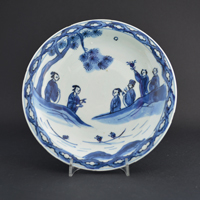
CHONGZHEN 1628 – 1644 Transitional Porcelain
A Transitional Blue and White Porcelain Dish for the Japanese Market, Late Ming Dynasty, Chongzhen Period 1628 – 1644. Depicting Three of the Eight Immortals to the Right with Three other Figures. The Unidentified Scene Depicts Han Xiangzi Holding His Flute, Lan Caihe with a Flower Basket on His Head and Zhang Guoloa Holding His Hands Out, Performing a Feat of magic for Which He is Famed.
SOLD 22247
- Condition
- Very good, some Mushikui (insect-nibbled) fritting.
- Size
- N/A
- Provenance
- From a Private English Collection of Chinese Porcelain.
- Stock number
- 22247
- References
- For a late Ming dish of this design from the Butler Family Collection see : Trade and Transformation, Jingdezhen Porcelain for Japan, 1620-1645 (Julia B.Curtis, China Institute Gallery, New York 2006) page 111, plate 92. This most excellent catalogue dates the dish to c.1635-1645 and notes that "The utter lack of perspective in the scene, the improbable placement of the figures, and the inconsistent scale between the figures and the boats would have rendered the dish unacceptable to all but the Japanese at the time". For a set of five Ming blue and white porcelain dishes of this design, dated to the Tianqi period (1621-1627), see : The Peony Pavilion Collection : Chinese Tea Ceramics for Japan (c.1580-1650). Christie`s London 12th June 1989 lot 268. For another Ming porcelain dish of this design see our `Sold Items` number 22245.
Information
Ming Porcelain for Japan :
During the late Ming Period the Chinese made a large among of porcelain for the Japanese market, it was made from the Wanli period (1573-1620) and ended in the Chongzhen period (1628-1644), the main period of production being the 1620`2 and 1630`s. The porcelain objects produced were made especially for the Japanese market, both the shapes and the designs were tailored to Japanese taste, the production process too allowed for Japanese aesthetics to be included in the finished object. Its seams firing faults were added, repaired tears in the leather-hard body were too frequent to not, in some cases, be deliberate. These imperfections as well as the fritting Mushikui (insect-nibbled) rims and kiln grit on the footrims all added to the Japanese aesthetic. The shapes created were often expressly made for the Japanese tea ceremony meal, the Kaiseki, small dishes for serving food at the tea ceremony are the most commonly encountered form. Designs, presumably taken from Japanese drawings sent to China, are very varied, often using large amount of the white porcelain contrasting well with the asymmetry of the design.
The Eight Immortals :
The Eight Immortals are a group of legendary Xian, immortals or transcendents in Chinese mythology. Each Immortals power can be transferred to a power tool that can give life or destroy evil. Together, these eight tools are called `Covert Eight Immortals`. Most of them are said to have been born in the Tang Dynasty or Song Dynasty. They are revered by the Taoists, and are also a popular element in the secular Chinese culture. They are said to live on Penglai Mountain-Island. The Immortals are : Immortal Woman He (He Xiangu),Royal Uncle Cao (Cao Guojiu),Iron-Crutch Li (LiTieguai),Lan Caihe,Lü Dongbin,(leader)Philosopher Han Xiang (Han Xiang Zi),Elder Zhang Guo(Zhang Guo Lao),and Zhongli Quan.